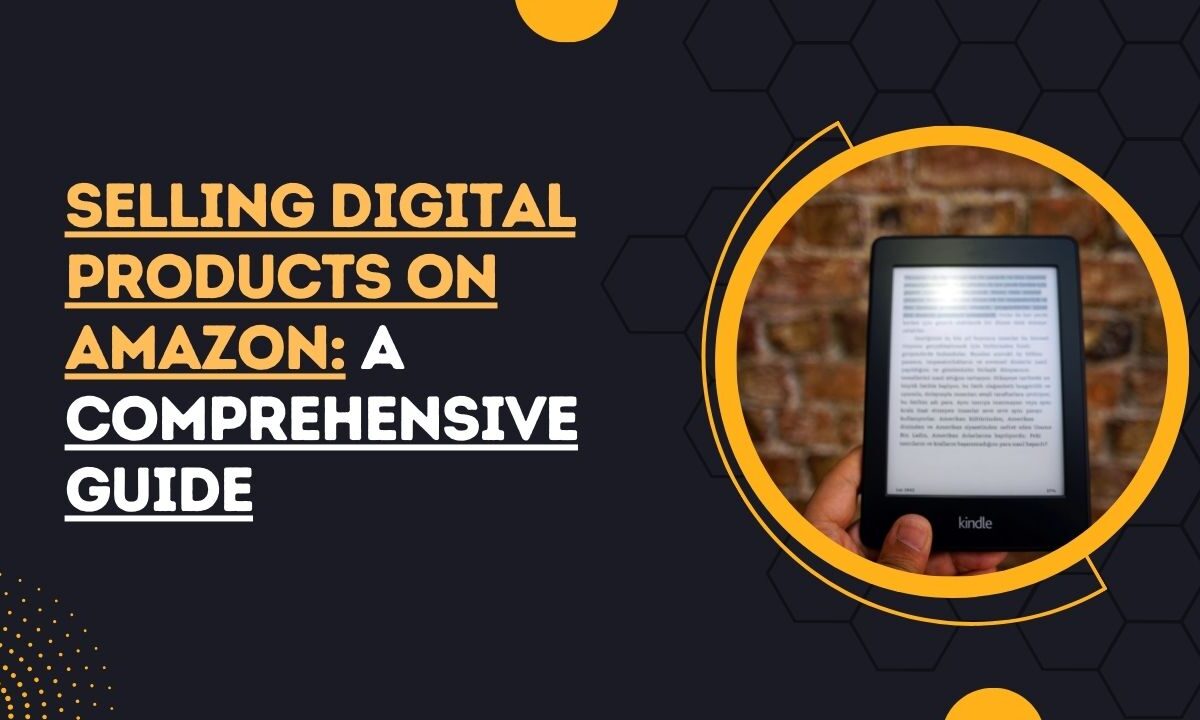Selling Digital Products on Amazon: Comprehensive Guide
Selling digital products on Amazon can be turned into a profitable business with some creativity and effort
Do you like listening to podcasts or are more drawn to audiobooks and ebooks on Kindle and Audible? If yes, you are already an avid digital product consumer.
The digital products industry is growing at a rapid pace and experts predict it will cross $135 billion in 2024.
So. Why not tap into this huge market and monetize your artistic skills?
Whether you like to create books, graphics, or even music, you can sell it all on Amazon.
But where do you start from?
Right here.
In this article, I will share how you can sell your products on Amazon like a pro.
So, let’s dive straight into it.
1. Understanding Amazon’s Platform Selling Digital Products
Amazon is a pioneer of ecommerce and holds over 38% of the market share.
However, most people fail to realize that it is also among the best platforms to sell digital products.
Now, you may wonder what’s so special about Amazon.
After all, there are other platforms where you can sell digital products, such as Etsy and Gumroad. The difference is the trust and the global market Amazon holds. Let’s explore the benefits of selling on Amazon.
If you want to know more about what type of products you can sell on Amazon, you can check out my previous blog post, The Best-Selling Digital Products On Amazon (Mini Guide).
Here I have explained each digital product in detail, so you pick the ones suited to your interests.
1.1. Benefits of Selling Digital Products on Amazon
Massive Customer Base:
Amazon has millions of active users worldwide.
Even people living in the remotest parts of the world know about it.
This ensures you have access to a diverse and extensive market as soon as you register on the platform.
Customer Trust:
Another great thing about Amazon is that it has spent years building a reputation for quality and customer service.
By selling on Amazon, you automatically earn the consumer’s trust to at least try your products once and if you deliver quality, you can quickly create a loyal customer base.
Integrated Payment Systems:
Amazon is very stringent about how transactions are handled and has set up high-security payment systems to prevent data theft and payment fraud.
So sellers can rely on its established payment methods for secure transactions and payment processing.
Cross-Promotion Opportunities:
Amazon has always focused on delivering value to its customers and focuses on increasing customer satisfaction levels.
Hence, it has built innovative recommendation algorithms that will promote the right products to customers based on their browsing and purchasing history.
Amazon Prime Eligibility:
We all know about the prime benefits of early delivery and free delivery when it comes to physical goods.
Yet, it doesn’t end there are many prime features that one can leverage for digital products Prime is typically associated with physical goods.
Digital products can also leverage Prime features, such as exclusive and early access to books, movies, and more.
Detailed Analytics:
Amazon has an amazing analytics platform that gives sellers sales data insights to better understand consumer behavior.
These insights allow you to tailor your offerings to better meet the needs of your target audience.
User-friendly Interface:
Amazon’s platform is user-friendly for sellers. Anyone with limited knowledge or experience can use it, as everything is streamlined.
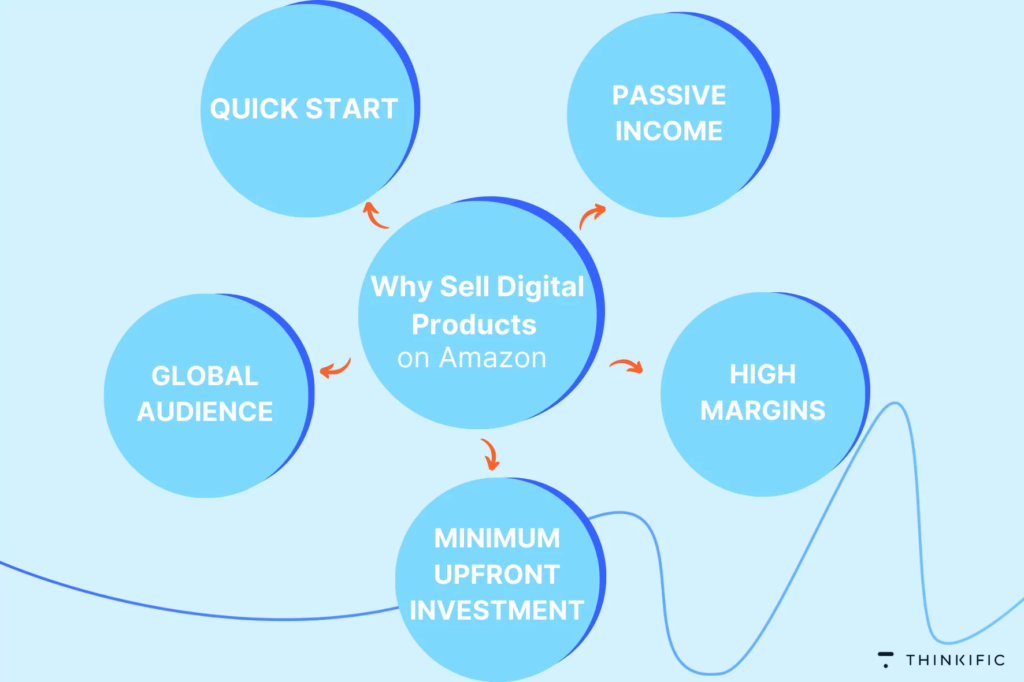
By leveraging these benefits, you can maximize profitability and growth potential on Amazon.
Benefits of Selling Digital Products on Amazon
| Benefit | Description |
|---|---|
| Massive Customer Base | Access to millions of potential buyers worldwide. |
| Customer Trust | Leverage Amazon’s trusted reputation to enhance your product’s credibility. |
| Integrated Payment Systems | Simplified and secure payment processing through Amazon’s system. |
| Cross-Promotion Opportunities | Utilize Amazon’s platform to promote other products and boost sales. |
| Amazon Prime Eligibility | Increase visibility and sales potential with Prime member benefits. |
| Detailed Analytics | Access comprehensive data to track performance and optimize strategies. |
| User-friendly Interface | Easy-to-navigate platform for both sellers and buyers. |
Read More: The Best-Selling Digital Products On Amazon (Mini Guide)
2. Setting Up Your Seller Account
Now that you know why Amazon is the best place to sell your digital products, we can move on to the next stage, which is setting up your seller account on Amazon.
Before we discuss the detailed steps, you should know that Amazon offers two seller account options: individual and professional.
I will share how these vary and how to set up both.
2.1. How to Register on Amazon as a Seller
Step 1: Start by visiting the Amazon Services website.
Step 2: Choose your account type: Here you need to decide whether you want an individual or professional account. If you opt for an individual account, you can sell only up to 40 items monthly.
If you opt for a professional account, you increase that number to unlimited and become eligible for top placement on product pages.
The only catch is a professional account is paid and you have to pay a monthly subscription fee of about 40 dollars.
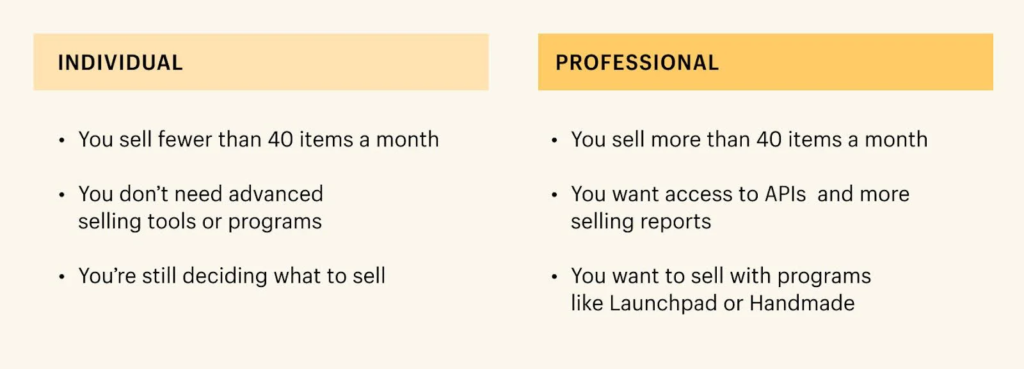
If you are a beginner, an individual account is the best option you can expand later on.
3rd Step : The next step is to add your business information, such as legal business name, contact information, address, company registration number, and other details.
Step 4: You also need to add your billing information, such as banking details, and don’t forget the tax information, such as your Social Security Number or your business’s Federal Tax Identification Number.
Step 6: After filling out all the details, you have to wait for your account to be verified. During verification, you may have to provide documentation.
Once verification is complete, you are all set to sell on Amazon.
But before you start to list your products there are certain things you need to take care of. Let’s take a look at them.
2.2. Necessary Preparations for Selling Digital Products on Amazon
- Digital Rights Management (DRM): The first thing you need to do is to take care of your DRM. When selling digital products, you need to ensure DRM is in place so you don’t face the problem of unauthorized distribution.
- Copyright Compliance: Copyright ensures that the products you sell are legally yours to sell and no one can claim their ownership later. Get the necessary licenses and permits to prevent copyright infringement.
- Product Descriptions and Metadata: Having the right product descriptions helps customers understand what they are buying, and the metadata helps Amazon to list your product in the right categories. So, ensure you have clear metadata and descriptions with proper keywords and category details for each product before listing them.
- Prepare for International Customers: The best part of digital products is that there is no logistics involved and anyone across borders can purchase your products. However, they still have to follow the laws and regulations of the country you plan to take them in. So ensure you meet those laws before going international.
Read More: Creating Quality Digital Products For Amazon: Best Practices
3. Listing Your Digital Products
Once you have taken care of the legal aspects, you can move on to listing your products.
3.1. How to List Your Digital Products?
- This is where things get exciting, the first step is to log into your Amazon Seller Central account–the place from which you will manage your entire account.
- Next, you need to search the inventory menu, find the add products option and click on it.
- After that, you need to choose a category for your digital product. It can be music, ebooks, software or something else. Please ensure it best fits your product nature.
- Then you have to fill out all the details of your product including keywords, description title, and add images.
3.2. Tips for Writing Great Product Descriptions
- Be Clear and Precise: The intent behind a product description is to explain to the target audience what they are buying. The best way to do that is to keep it simple and to the point.
- Highlight Key Features: Focus on the USP and the prominent features of your digital product. Take care not to exaggerate and make fake claims.
- Use Bullet Points: Using bullet points makes it an easier read and consumers can find what they are looking for quickly.
- Provide Technical information: Don’t forget to mention the technical specifications or integrations needed to use your products.
- Add a Call-to-Action: Encourage potential buyers with a good call-to-action to buy your product.
3.3. Why Keywords Are Essential for Amazon SEO?
Amazon has internal algorithms that pick the best products for its customers to increase customer satisfaction. Optimizing your product details with the right keywords is how you can ensure customers see your products. Here’s what you can do:
- Choose the Right Keywords: Use tools like Amazon’s Keyword Tool, Google Keyword Planner, or other SEO tools to research the right keyword for your products.
- Incorporating Keywords: Don’t forget to add them to the title description of the products. Also, include them in the backend keyword section of Seller Central.
- Monitor and Optimize: It is also crucial to monitor whether the keywords are working or not and to optimize them from time to time.
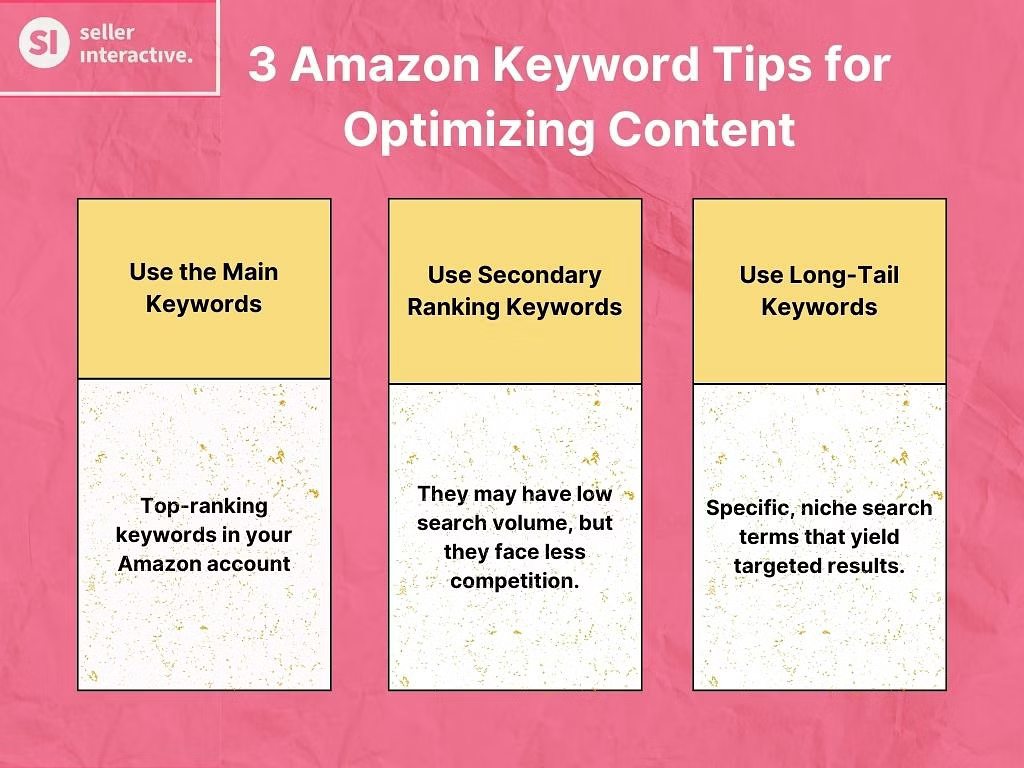
Image Source: Seller Interactive.com
With this, the listing process is complete and we can move on to the next most crucial section of selling your digital products on Amazon, i.e. Pricing.
4. Pricing Strategies for Your Digital Products
The pricing of your products plays a vital role in your customers’ purchasing decisions. It needs to be reasonable to the customer and at the same time profitable to you.
But how do you achieve that?
In this section, we will look at different strategies you can adopt.
4.1. How to Set Competitive Prices for Digital Products?
- Analyze the Market: First, you need to understand the market conditions. For that, you can search for existing products on Amazon similar to yours. This will give you a broad idea of the price range.
- Consider Costs: Knowing the cost of your product is critical, as it will help you set the base value. Don’t forget to add Amazon fees and any overhead costs to your production costs.
- Use Psychological Pricing: There are certain psychological tactics like using prices ending in .99, known as charm pricing, that you can try to make your pricing more attractive to customers.
- Don’t Forget About the Competition: Stay informed about what your competition is charging for their products. And while selling at a lower rate is a great strategy, it can backfire sometimes. Customers may believe that the very low price is because of low quality. Hence, set prices that reflect the quality and value of the product even if it is a bit higher than competitors.
4.2. Examples of Successful Pricing Strategies
Certain strategies are tried and tested by successful sellers that you can incorporate in your pricing. Let’s take a look at them:
- Dynamic Pricing: It is quite a successful pricing method used by many sellers where they adjust the price regularly based on the algorithms that consider demand competition and other market factors.
- Bundling: Bundling is an effective pricing strategy wherein one product is bundled with another at discounted rates, so the buyer gets more value at a lower price.
- Discounts on Subscription Purchases: Providing additional discounts on products when a buyer takes their subscription or repeat orders is also an effective pricing strategy that has provided good results.
- Price Skimming: It is an effective strategy when you have highly innovative or limited-edition products. In this strategy, you launch the product at a higher price and slowly reduce it as the saturation happens.
With these strategies, you can efficiently price your products and gain profits.
5. Marketing Your Digital Products
Marketing your digital product is a critical aspect of successful sales on Amazon.
There are different ways to do it. Let’s take a look at a few of those strategies:
5.1. Advertising Within Amazon
- Amazon Advertising Platform: The first place you can easily advertise your digital products is Amazon itself through sponsored ads. This way your product appears on the Amazon app when people search for related keywords and products.
- A+ Content: If you have a brand registry you can leverage the A+ content feature to add rich images and snippets to promote your products on Amazon.
- Amazon Deals and Promotions: You can participate in different Amazon sales and deals such as lightning deals to promote your product sales.
- Enhanced Brand Content: Just like A + content, enhanced brand content enables you to add product descriptions with additional photos, comparison charts, and more.
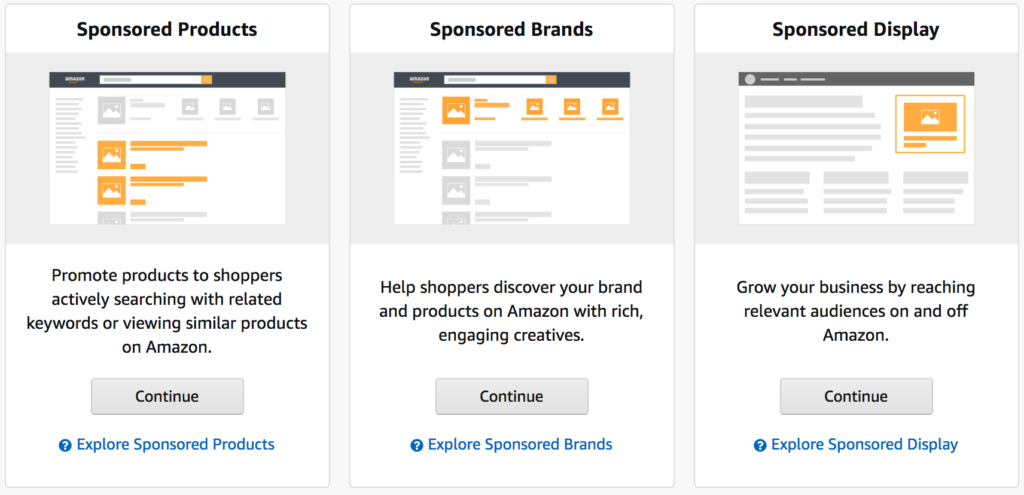
5.2. External Advertising
- Social Media: You can leverage different social media platforms like Facebook and Instagram to promote your products with how-to guide posts and also use influencer marketing to promote your products.
- Content Marketing: Use blog posts, videos, and infographics to promote your digital products through content marketing.
- Email Campaigns: Running email campaigns is a great way to target your audience to encourage them to buy products, give updates, and more.
Here’s an easy guide for beginners to learn how they can craft powerful email newsletters.
By leveraging a combination of internal and external methods you can promote your digital products on Amazon.
FAQs
1. How do I set up a seller account on Amazon?
To set up a seller account, visit Amazon Seller Central, choose between the Individual or Professional plan, provide business and contact information, payment details, and tax information, then complete the verification process.
Ensure you review Amazon’s policies and guidelines.
2. What preparations are needed before selling digital products on Amazon?
Ensure your digital product is finalized and formatted correctly, research market demand and competitor pricing.
Make sure you comply with Amazon’s digital product policies, and prepare detailed product information including high-quality images and accurate descriptions to attract buyers.
3. How do I list my digital products on Amazon?
Log into Seller Central, select “Add a Product,” choose “Digital Products,” and enter the required details like title, description, price, and keywords.
Upload your digital file following Amazon’s formatting guidelines, ensuring it meets quality and content standards.
4. Why are keywords essential for Amazon SEO?
Keywords help your product appear in relevant search results, directly impacting visibility and sales.
Use tools like Amazon’s Keyword Planner to find high-ranking terms. Incorporate these keywords naturally into your title, description, and bullet points for better SEO performance.
5. How can I set competitive prices for digital products?
Research similar products to gauge market rates, consider your production and marketing costs, and factor in the perceived value of your product.
Use Amazon’s pricing tools to monitor competitor pricing and adjust your prices to stay competitive while maintaining profitability.
6. What are effective marketing strategies for digital products on Amazon?
Utilize Amazon’s advertising options like Sponsored Products and Sponsored Brands. Create compelling, keyword-rich product descriptions and use high-quality images.
Leverage external advertising channels such as social media, email marketing, and influencer partnerships to drive additional traffic to your listings.
Related Posts
The Best-Selling Digital Products On Amazon (Mini Guide)
Creating Quality Digital Products For Amazon: Best Practices
Monetizing Your Blog: Multiple Income Streams for Profit
Earn Money From Blogging Like A Business
Conclusion
In reality, selling digital products on Amazon is a simple procedure with an intuitive user interface. Alongside that, detailed analytics improve the situation.
Establishing your seller account is a simple first step, so make sure you’re ready for the platform.
For the best SEO, efficiently list your digital products with engaging descriptions and keywords.
Use a competitive price strategy to draw customers and increase revenue.
Lastly, use both internal and external advertising to improve your listings’ exposure and traffic.
You’ll be well-positioned to thrive in Amazon’s dynamic marketplace if you follow these measures.

